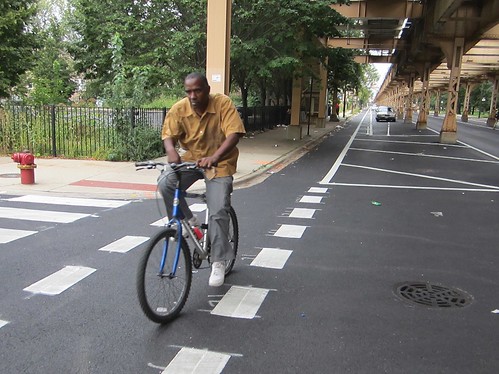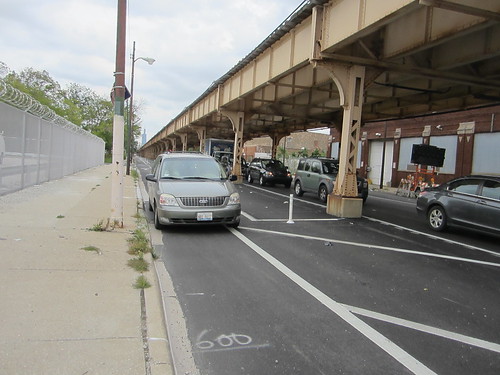As part of the Mayor Emanuel’s goal of building 100 miles of buffered and protected lanes in his first term, the Chicago Department of Transportation is chugging along building new bikeways. Last week, I checked out buffered lanes on Central Park Avenue, between Jackson and Franklin boulevards, and protected lanes on Lake Street, from Central Park to Laramie Avenue.
Let’s start with the less controversial of the two bikeways, Central Park. As has happened in many other parts of town, CDOT has upgraded existing conventional lanes here by adding additional dead space on one side of each lane.

In areas where there’s no parking lane, or a parking lane that gets little use, the buffer has been striped on the left side of the bike lane, to help keep cyclists away from car traffic. In sections where there is a heavily used parking lane, the buffer is striped on the right side of the bike lane, to encourage cyclists to ride out of the door zone. Pavement quality is decent, and workers have patched some potholes with asphalt.

The new two-mile stretch of protected lanes on Lake extend the PBLs that CDOT built on Lake from Damen Avenue to Central Park back in 2012. In the near future, an additional mile will be built on Lake from Laramie to the city limits at Austin Avenue.
As I wrote last April, some cyclists questioned whether it made sense to extend the existing protected lanes on Lake. Although the street is designated as a bike-priority Spoke Route in the city’s Streets for Cycling Plan 2020, it runs underneath Green Line tracks, which means there’s less sunlight, the ‘L’ pillars block sight lines at intersections, and there’s deafening noise from the occasional train overhead.

The existing protected lanes on Lake were rarely plowed last winter, which had record snowfalls. During the warmer months the lanes were often littered with broken glass, garbage and other debris. Active Transportation Alliance director Ron Burke told me he agreed that the lanes weren’t very usable as-is, and that he’d requested that CDOT sweep and plow them more frequently.
Since then, the department has been sweeping all the city’s PBLs more frequently, according to CDOT transportation planner Mike Amsden. Every third week, the department has access to a street sweeper and, during that week, each protected lane is swept two or three times.
The new PBLs between Central Park and Laramie currently have less debris than I’d seen on the old stretch, although I did have to dodge a fair amount of broken glass when I rode them last Wednesday. Otherwise, the lanes are about as nice as Chicago-style protected lanes located under train tracks possibly could be. The new pavement is smooth as velvet, the thermoplastic markings are crisp and neat, and there are plenty of flexible posts to separate cyclists from traffic.
Most of the new stretch features parking-protected lanes. In some areas west of Pulaski Road the bike lanes are buffered lanes, located to the left of a curbside parking lane. In other sections where’s no parking, the bike lane is curbside, with a buffer and posts.

In general, the new lanes seemed to function well. However, during the evening rush, when westbound car traffic backed up at some intersections, I noticed that some motorists were entering the protected lane and using it to pass the stopped vehicles.
James Thomas, 60, was pedaling from his home near Ashland Avenue and Madison Street to make an estimate for a painting job in Austin. He said he often uses a bike to get around. “It’s good exercise, and it can save you a lot of time and money.”

Thomas gave the new bike lanes a thumbs-up. “This feels nice and safe,” he said. He added that he feels more comfortable riding in protected lanes than on streets like California Avenue south of Lake, which simply has shared-lane markings, requiring cyclists to bike closer to moving traffic.









